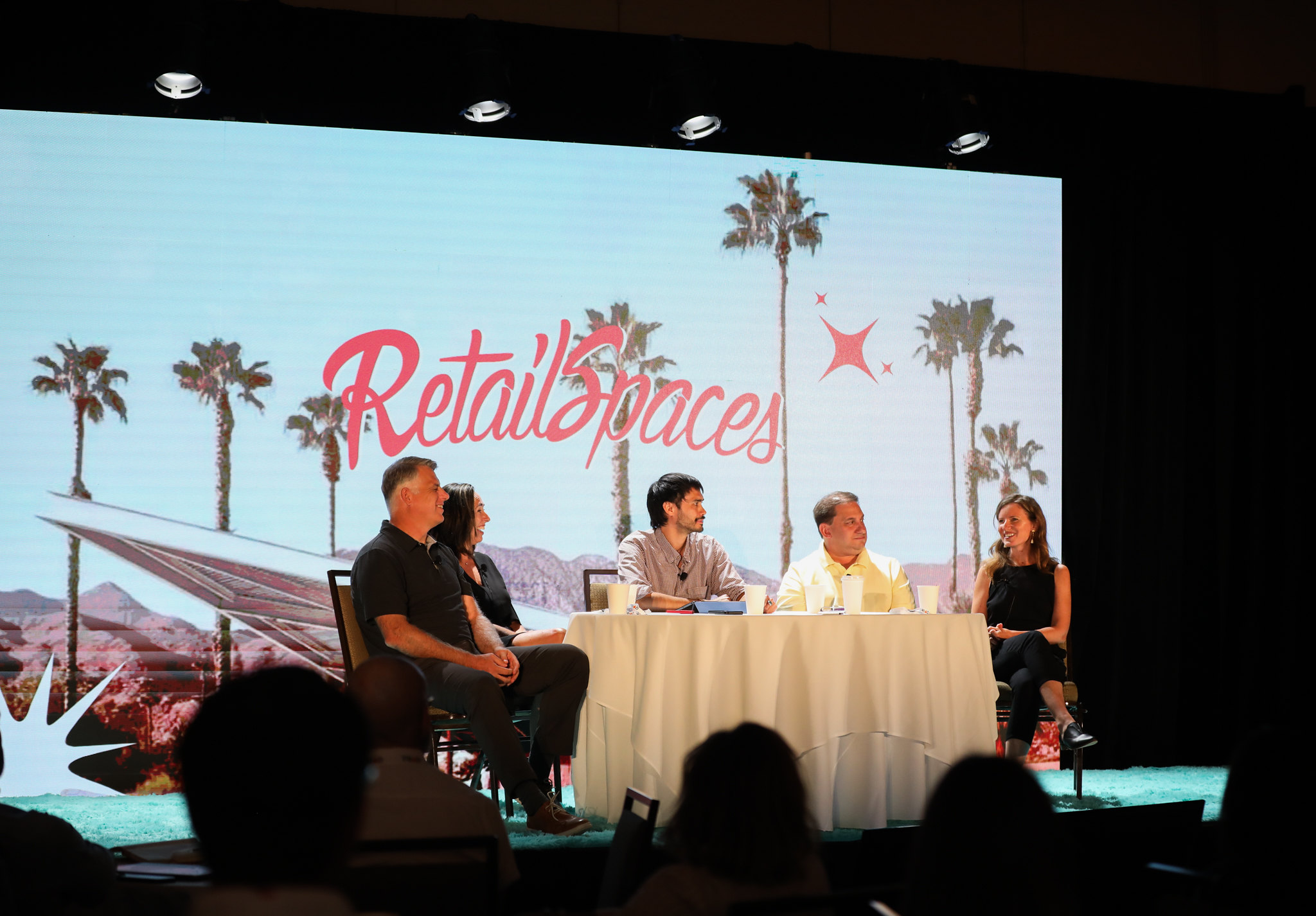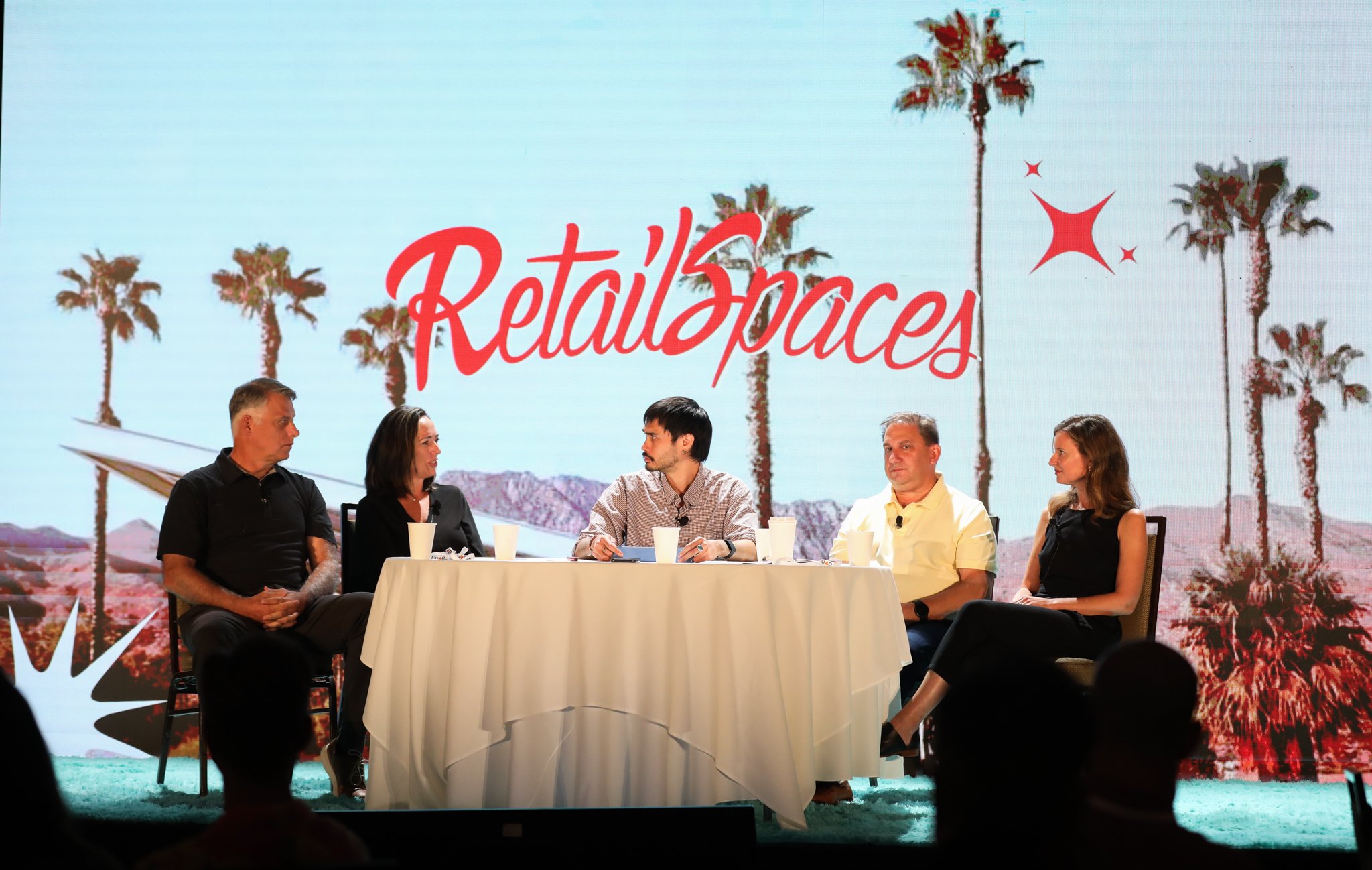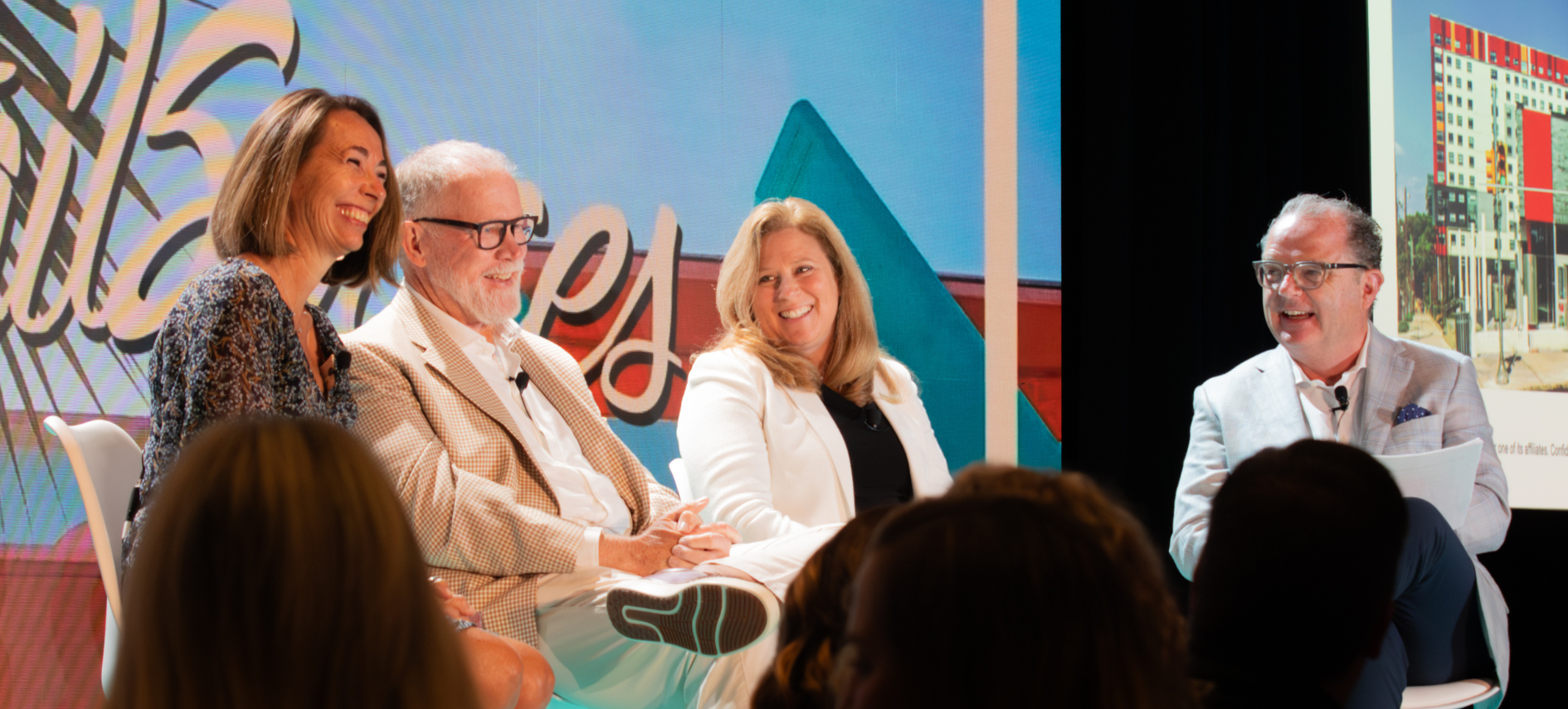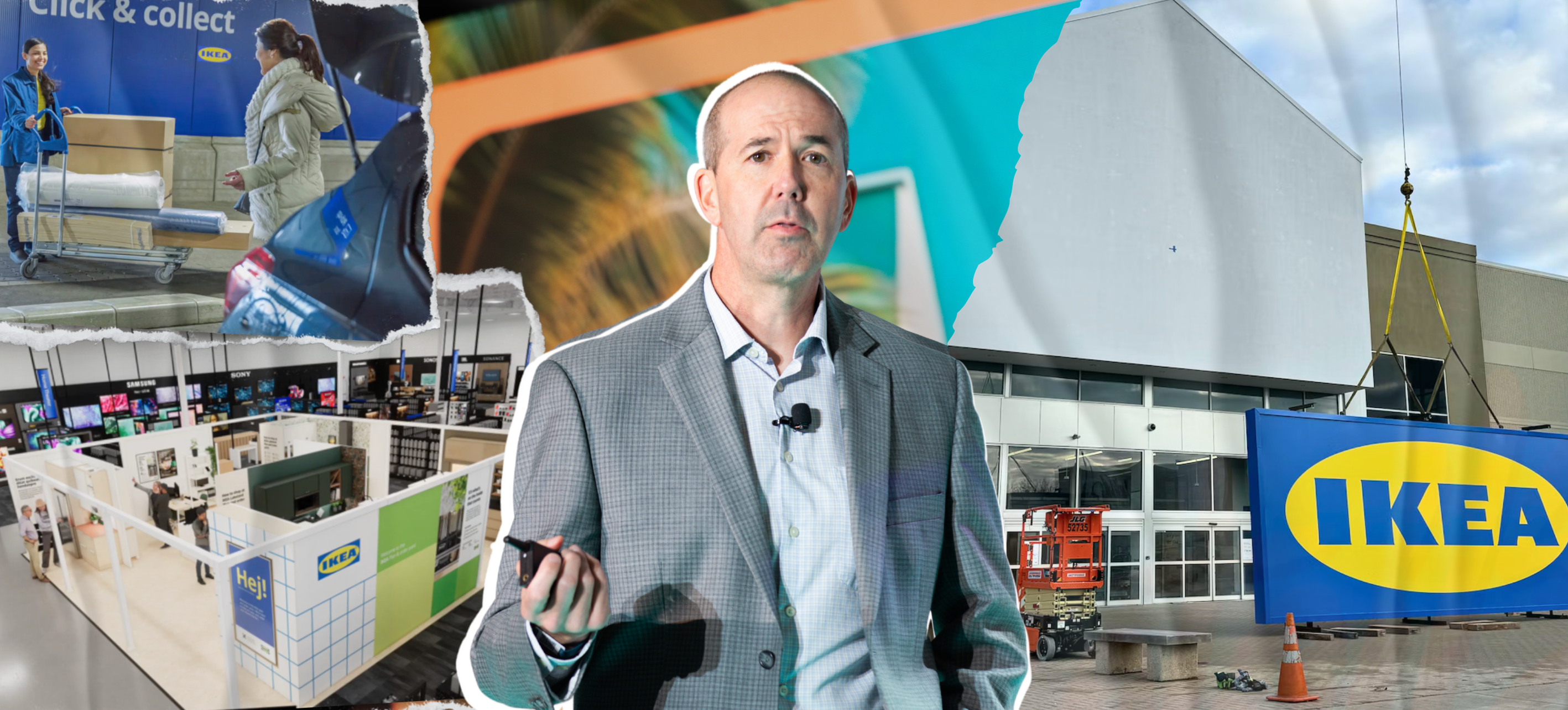Four store development and design veterans put their heads together at RetailSpaces in Palm Springs, CA, for an illuminating discussion about the industry’s present and future: the obstacles they’re facing, how they’re navigating new tech and work paradigms, and where they see the world of retail heading over the next ten years.
Moderated by RetailSpaces producer Jason Schwab, the panel included Heidi Blesy, VP of Studio Development at [solidcore]; Danni Gallagher, VP, Construction at CVS Health; Steve Lamontagne, VP, Portfolio Optimization at Sprouts' and Jeff Gray, VP, Store Development at Hibbett. During their hour-long conversation, they explored the biggest challenges facing retailers big and small, across all segments — reflective of the broad, category-spanning RetailSpaces audience.
Embracing Creative Destruction
With customer behaviors ever-evolving, retailers continue to face constant pressure to evolve their store formats and experiences accordingly. Hibbett offers a prime example of this pressure and how to deal with it, having spent the last several years breaking out of its niche in sporting goods.
“We’re more of a fashion retailer now,” Gray said. “We have some stores that have zero equipment in them. We really tried to focus on what the customer's looking for, and how they want to get it. Online sales have really changed how you do a lot of things.”
He stressed the need not only to keep up with consumer behaviors but to continue giving customers a seamless experience both online and in-store.
"Everything that we do to the store, how does it optimize the customer experience that day, and how does it tie back into the online presence?" he asked. "They're all tied together. If the customer is buying it online, we want them to pick it up in the store if they can. If they return it, we want them to return it in the store if they can, so we give them incentives to do that. As we design the store, as we build the store, we're taking all those things into consideration."
The Impact of AI + Other Emerging Tech
Of course, it’s not just customer behaviors that are evolving. Recent developments in artificial intelligence and other technologies have lit a fire under retailers (and pretty much everyone else), offering new challenges and new solutions in equal measure. There’s no one-size-fits-all approach to these emerging paradigms, the panelists agreed: rather, the key is to remain flexible, identifying pain points where AI tools can make employees’ and customers’ lives easier.
At CVS Health, that means virtual surveying, fleet monitoring, automated customer interactions, and other applications.
“We're trying to find efficiencies with it,” Gallagher said of the company’s AI strategy, stressing that it’s not a means of replacing human work. ”It's not so much about, ‘Is it doing our job?’ I think it's, "Is it making our world more efficient or more streamlined? Is it helping us progress with what we've gotta do?”
Blesy cautioned against losing the personal element that keeps customers coming back, especially in businesses that revolve around human relationships.
“Personal engagement in the studio is something that can't be replaced,” she said, suggesting that [solidcore] might explore AI applications in its backend technology. "We're really doubling down on that personal experience, working with a coach individually. What does it feel like when you come into one of our locations? Somebody knowing your name, knowing about you is so important.”
Lamontagne agreed, arguing that what AI can do for a company largely depends on how mature that company is. (At Sprouts, he uses Power BI to inform his decision-making, especially when it comes to expanding into new territories.) But even the most advanced automation technology can’t replace the power of a human touch. He recalled a recent trip to Ace Hardware, where he was about to drag several heavy bags of salt to his car when the cashier touched his wrist and told him not to worry: their team would handle it.
"That's what resonated in my head—nothing else, not the price," he said. "There was this bond and that connection. I'm always gonna buy salt from that Ace Hardware every time I need it now. They’ve got a customer for life."
Sustainability Front and Center
Sustainability efforts are top of mind, especially for retailers who cater to Millennial and Gen Z customers concerned with spending their money responsibly. For [solidcore], this translates to vigilance in the development and construction process.
“It really has to do with not adding too much stuff to our buildouts: not layering on a lot of decoration, not layering on a lot of obsolete pieces,” Blesy explained. “It’s being thoughtful: is this material going to last? Both aesthetically and durability-wise, for the duration of at least the first lease term, so that we aren't throwing things away.”
From her perspective at a rather larger retailer, Gallagher added that it’s important to look at the social aspects of sustainability as well.
“My teams right now are focused on, can we take any of our dark locations and partner with the communities? Can we give back in other ways that kind of change the footprint?” she said. “In order for us to really move it forward, it isn't just gonna be 'can we go to more sustainable materials' or 'can we get rid of the floor covering and just do concrete,' but it's gonna be these layering impacts that we have.”
Building Resiliency & Flexibility
Another persistent challenge: navigating remote work paradigms. The panelists acknowledged both the importance of in-person work and the need for organizations to stay flexible.
"You have to have a reason to come in and make it worth the effort," Blesy said, clarifying that this is both a design challenge and a cultural one. “How do you both physically and culturally curate that environment so that people don't question the time commitment of making the effort to come into the office?”
"We've all gotta be nimble and creative enough to say, 'It's okay for you to be on Teams and I'll be face-to-face, and we'll collaborate and then we'll move into the next meeting,'" Gallagher added. "It has absolutely changed the way we do business. I take fewer meetings from the road. I end up doing more at my desk because I gotta be on Teams and try to get my face on camera and be one-on-one with the team. So I almost feel more connected to some of them, just because we're in that virtual platform.”
It’s not just the office landscape that’s still feeling the impact of the last few years. The development process continues to suffer from devastating bureaucratic delays, especially when it comes to permitting processes. “Permitting is crazy,” Gray said. “All the cities let everybody go when Covid happened, and then they either didn't rehire them or they hired less experienced people back. So what used to take 30 days to get a permit now is 90, 150 days.”

The delays are enough to hobble development strategies even for a chain as big as CVS. “Add in the boards and the health departments and layer in the inspections—by the time you've gone through all of those hoops, you've spent six months. Speed to market is no more,” Gallagher said. “You literally are planning 12 months out in front of you. And you can't test anything because you gotta keep moving, and somebody's trying to beat you to the market.”
There’s no quick fix to a problem of this scale. As Blesy pointed out, the issue comes down to misaligned incentives: local governments just don’t have the same incentives to move quickly as companies, landlords, general contractors, architects, and suppliers all do. Still, the panelists suggested that one way to mitigate these impacts is to build resilient vendor networks to navigate the ebb and flow with you.
“We are big on really thinking of our partners as an extension of the team,” Blesy said. “Just thinking through, how do you bring people along and truly give them the visibility, transparency, the partnership to be an extension of your team? And pair that with the critical roles that you need to support that and keep them motivated.”
Lamontagne agreed, adding that he tells his vendors he wants them to feel like a part of his own team. This is especially helpful when it comes to dealing with supply chain challenges, allowing logistics partners to become a central part of the planning and execution of any project. “Having that expertise at the table becomes critical,” he said.

Posted by
Physical Retail Reimagined.
RetailSpaces is a community for store development and design innovators.
March 29-31, 2026 | San Antonio, TX
Learn More!


-4.png)

-4.png)



Comments